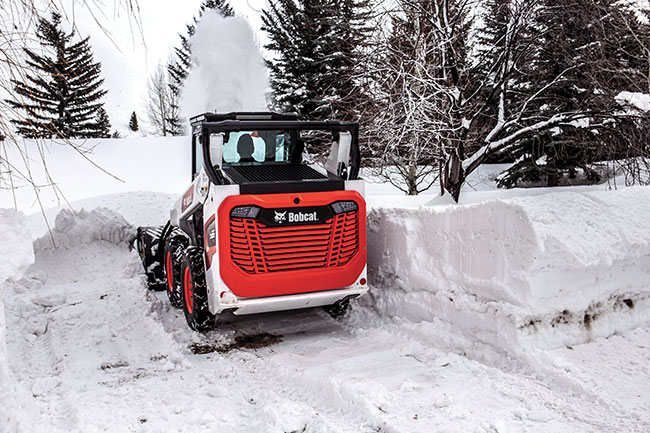
Features
Fall/Winter Preparations
Golf & Landscaping
Municipal
Snow & Ice
Planning needed for snow services
With the right equipment and plan, winter services can enhance landscaping business
June 23, 2021 By Randi Bakalar
 Before deciding on adding snow services, landscaping companies need a business plan, a fleet assessment and an employee training program. Photo courtesy Bobcat.
Before deciding on adding snow services, landscaping companies need a business plan, a fleet assessment and an employee training program. Photo courtesy Bobcat. Sometimes it seems like the cold winter months means fewer jobs and contracts, but it doesn’t have to be that way. With the right equipment winterization and plan, you can achieve success throughout the year.
If you are looking to extend your working season and generate additional revenue once the snow flies, consider adding snow and ice removal services. Before you go all in on accepting jobs, plan ahead with these three best practices.
Review your business plan
Before taking on winter jobs, make sure you have a clear objective for your snow removal business. Assess your individual needs and determine what kinds of jobs make sense to take on. In addition, ensure you have a financial cushion to get you through any possible scenario. This decision will be unique to your company, staffing situation and equipment availability.
Ask yourself the following questions:
• Is your business staffed properly for the unpredictability of snow jobs? Will you need to hire seasonal workers? Does your compensation structure need to change to accommodate longer hours, off-hours work and/or on-call work?
• How will you secure business during this time of year? Do you have existing clients who you can network with about your new offerings? Do you need to market your company to new customers?
• Is your financial foundation strong enough to take on the risk of expanding business operations?
• Do you have the appropriate insurance to protect your company and employees?
• What are your metrics of success? How will you determine if you maintain off-season work as a long-term business strategy?
Assess your fleet
You may find that additional equipment will be needed to diversify your business. Whether you are considering purchasing new or pre-owned equipment, this step will ensure that you’re fully prepared to take on drastically different working conditions.
If you’re starting small and easing into snow removal, renting can give you a chance to adjust to new challenges. It also gives you and your employees the opportunity to try different equipment and determine the right choice as a long-term investment.
Consider the following when assessing your fleet:
• Will your equipment need to fit in tight spaces, like residential areas, or will you be working in open areas, such as parking lots?
• Are you picking up snow with a bucket and loading it into a truck, requiring extra lift and reach, or are you moving/pushing snow into piles? A vertical lift machine is ideal if you are loading snow into high-sided trucks. A radius lift machine works well when working at mid-range or lower working heights.
• Will you be switching between multiple attachments while removing snow? If so, consider looking at a machine that has a power attachment system which allows you to quickly switch between non-hydraulic attachments without getting out of the cab.
• Is the lighting adequate where you’ll be clearing snow? Optional side lighting and road kits are very important in low-visibility situations. Back-up alarm kits are also a good idea if you’re regularly working at night or in confined areas.
With the right equipment and attachments, you will be well on your way to diversifying your business year-round.
Train your employees
Winter and snow removal can present a unique set of challenges. Here are some safety tips for you or your equipment operators:
• Read the operation and maintenance manual before operating any piece of compact equipment. Understand and follow the operating instructions and avoid the hazards identified on the machine decals.
• Refer to the maintenance instructions on filling your equipment with the correct fluids in the correct increments to ensure it performs like it should.
• Always face the machine when getting in, grabbing the handles and using the steps that are provided, maintaining three-points of contact at all times.
• Never attempt to start the engine or operate the controls from outside the machine.
• Look in the direction of travel when backing up, and check each side before swinging or turning the machine. Consider adding a rear camera kit to your compact loader. The rear camera enhances your visibility to prevent contact with obstacles that may damage the loader and its components.
• Stop the machine on level ground when finished on a site. Always fully lower the lift arms and place the attachment flat on the ground, and turn the engine off before exiting the machine.
• Ensure your employees are familiar with the areas where they are removing snow. For example, if the equipment is stationed at an apartment complex or a shopping mall, train your employees on where the machines should be kept and to avoid potential obstacles (e.g., parked cars).
Don’t throw in the towel when cold weather arrives. Start thinking about how your business can adapt to work in snowy conditions. All it takes is careful planning, the right equipment and an operator-focused mindset to keep your business profitable year-round.
Randi Bakalar is corporate communications manager for Doosan Bobcat North America
This article is part of the Fall & Winter Prep Week Week.
Print this page